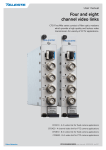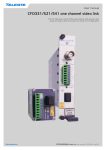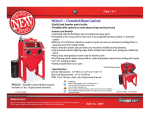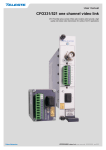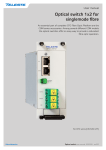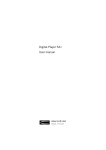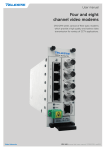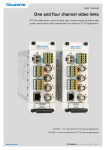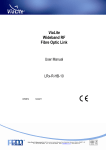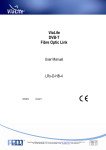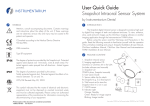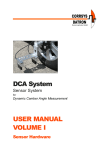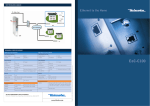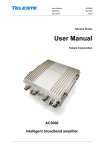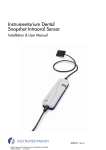Download CFO4x0/8x0 user manual
Transcript
User manual Four and eight channel video links CFO First Mile series consist of fibre optic modems which provide a high quality and losless video transmission for variety of CCTV applications. CFO410 - 4 ch video link for fixed camera applications CFO420 - 4 channel video link for PTZ camera applications CFO810 - 8 ch video link for fixed camera applications CFO820 - 8 ch video link for PTZ camera applications CFO410/420/810/820 user manual, 59300426, rev001 Contents Optical Transmitter & Receiver................................................................................................................................ 3 Introduction......................................................................................................................................................... 3 Features.............................................................................................................................................................. 3 Frame installation................................................................................................................................................ 4 Stand-alone installation....................................................................................................................................... 4 Video connections and indicator leds................................................................................................................. 4 S-video operation................................................................................................................................................ 4 Receiver alarm connection (all models).............................................................................................................. 4 Transmitter (CRT420/820) data wiring settings................................................................................................... 5 Receiver (CRR420/820) data mode and wiring settings..................................................................................... 6 Data termination and biasing.............................................................................................................................. 8 Link indicator led................................................................................................................................................. 9 Fibre connection................................................................................................................................................. 9 SFP transceiver module.................................................................................................................................... 10 To plug-in and unplug the SFP module, follow these steps.............................................................................. 10 Technical Specifications......................................................................................................................................... 11 CFO410/420/810/820 user manual rev001 Optical Transmitter & Receiver Single/multimode 4 and 8 channel video links for video only or video & bi-directional data operation CFO410 video link Welcome, and thank you for purchasing Teleste’s CFO Products. Vx4 Introduction CFO420 video link Vx4 Dx1 CFO810 video link Vx8 CFO820 video link Vx8 Dx1 The CFO410/810 series is a basic building block for multi-channel video transmission system providing uni-directional transmission of 4 / 8 uncompressed video channels over optical fibre. The CFO420/820 series is a basic building block for multi-channel video transmission system providing uni-directional transmission of 4 / 8 uncompressed video channels with one bi-directional data over optical fibre. PAL and NTSC video formats are supported to provide a transparent video transmission. With CFO420/820 models it is also possible to transmit one bi-directional RS data channel e.g. for PTZ control. All common data protocols are supported and are easily configurable by DIP switches. Optical transmission is based on hot-swappable SFP optics (class 1M). The high speed optics enable a full quality and a zero-delay (latency free) video transmission. Available SFP options are supporting 2 km transmission over multimode fibre or 20/40 km operation over single-mode fibre. As with all CFO Platform products the units meet all standard EMC and environmental requirements. All units are fully compatible with all CFO rack systems. Stand-alone options are available with the CMA module adapter and a separate mains adapter. Features • • • • • • • • • • • • CFO410/420/810/820 user manual rev001 Four and eight channel video multiplexer Alternative SFP optics for various optical needs Standard alternatives 2 km MMF, 20km SMF and 40 km SMF Four / eight CVBS (PAL/NTSC) video channels Video SNR 60 dB typical, 8 bit video sampling Data model supports RS-232, RS-422 or RS-485 Data rate up to 230 kbps Uncompressed zero delay digital transmission Common card units for rackmount or stand-alone installations Compatible with all CFO installation systems EMC and environmental conformance Feasible for temperature hardened operation (-34…+74 °C) 3 Frame installation 1 OPTICAL TRANSMITTER 2 IN- 3 LINK DATA IN+ OUTOUT+ GND 4 VIDEO 1 VIDEO 2 VIDEO 3 The CFO unit is to be pushed along the guide rails into the installation frame (e.g. CSR216 or 316 series) and secured with the four locking screws. The unit can be freely positioned in any slot in the frame. (Alarm card slot excluded). The empty positions in the frame should be blanked off with cover plates. The supply voltage is to be provided by a CPS384 or CPS390 power supply unit. Stand-alone installation The unit can be installed for stand-alone use by using a CMA series module adapter. The unit is to be pushed along the guide rails into the CMA module adapter and secured with locking screws. The stand-alone unit should be mounted to a vertical surface. The +12 VDC supply voltage is supplied by the means of a separate mains adapter with a regulated output, (e.g. CPS221 for CMA011 or CPS231 for CMA025). Video connections and indicator leds VIDEO 4 5 An example view for CRT420 optical transmitter (same information applies respectively to receiver unit CRR420). 1) Locking screw (4 pcs) 2) DATA connector (5-pin screw terminal) Note! Video only models do not contain a data connector (CFO410 & 810 series). 3) Slot for SFP optical tranceiver and link status led 4) Video input (BNC female) and video indicator led 5) Handle (with unit information) The impedance of the video connection (BNC female) is 75 Ω. The nominal input/output level is 1 Vpp. Video connection is equipped with the dual colour VIDEO led on the front panel. See table below for explanation of VIDEO indicator led’s lights. Colour Status Green A signal is present and in nominal level Yellow No video signal, or the video level is too low VIDEO indicator operation. S-video operation It is also possible to transmit two (CFO410/420) or four (CFO810/820) S-video signals that comprises separate luminance (Y) and chrominance (C) signals. This, however, uses two channels per one transmission channel. Connect Y and C signals to any of video inputs. Make sure that the Y and C connections are corresponding both at transmitter and receiver. No extra adjustments are needed. Receiver alarm connection (all models) Alarm at the rear connector of the unit is an open collector output, with the capability of 30 V/10 mA switching (alarm status = low imp.). Alarm Description Reason B Link status alarm No synchronisation achieved at optical input. Refer to documentation of CCU001/002 rack alarm cards. 4 CFO410/420/810/820 user manual rev001 IN- 1 IN+ 2 OUT- 3 OUT+ 4 GND 5 Transmitter (CRT420/820) data wiring settings The CFO420/820 link provides one bi-directional data channel (CRT <--> CRR). The connector in use is a screw terminal connector. Available data modes for data channel are RS232, RS422, RS485-2w and RS485-4w. See table below how to connect the desired data mode. The desired data connection must be confirm by the means of DIP switces. The desired data mode settings for data channel can be set by the means of receiver’s DIP switces (see page 7 for detailed description). The default factory setting is RS485-2w + dwelltime 75 µs, no line bias and no term. DATA connector (5-pin screw terminal). Pin RS232 RS422 RS485-2w RS485-4w in - in / out - in - in / out + Data inON 1 2 3 4 5 6 CRT420/820 DIP switches (SW1) for setting of pinout wiring. Data in+ in in + Data out- out out - out - out + out + Data out+ in + Screw terminal connector’s data pinout. Data type RS232 DIP switch position 1 2 3 4 off off off 5 off off RS422 off off RS485-2w on on RS485-4w off off - line bias on on - no line bias off off - termination on - no term. off Data connection settings for SW1 (DIP switch no 6 is not in use). CRT420/820 top view DIP swithes are located on the top of device. CFO410/420/810/820 user manual rev001 5 Receiver (CRR420/820) data mode and wiring settings CRR420/820 DIP switches (SW2) for data mode selection. The desired data mode settings including dwelltime settings for RS4852w can be set by the means of DIP switces. The default factory setting is RS485-2w + dwelltime 75 µs, no line bias and no term. RS485-2w Dwelltime settings Tx data Rx data Data mode Dwelltime ms Dip 1 Dip 2 Dip 3 Dip 4 Dip 5 Dip 6 Dip 7 Dip 8 0,01 on on on on on on on on RS232 0,02 off on on on off on off on RS422 0,04 on off on on on off on off RS485-2w 0,075 off off on on off off off off RS485-4w 0,1 on on off on 0,2 off on off on 0,4 on off off on 0,6 off off off on 1 on on on off 1,2 off on on off 2 on off on off 3 off off on off 4 on on off off 6 off on off off 8 on off off off 10 off off off off Data mode selection and RS485-2w dwelltime settings (SW2). Left side view CRR420/820 top view CRR420/820 DIP switches. Note! The data mode is only selected in the receiver. For SW1 please refer to page 5 for settings. 6 CFO410/420/810/820 user manual rev001 Data formats RS232 is an unbalanced data format (i.e. the signal wire working against a reference – ground). Simplex RS232 requires two connections (signal and ground). Full-duplex RS232 requires three connections (signal TX, signal RX and ground). RS422 is a balanced data format. Simplex RS422 requires three data connections (+/- and ground). Full-duplex RS422 requires five data connections (in+/ in-, out+/out- and ground). RS485 is used for full-multipoint communications where multiple transceiver devices may be connected to a single twisted-pair signal cable. Most RS485 systems use a Master/Slave architecture, where each Slave unit has a unique address and responds only to packets addressed to that unit. Packets are generated by the Master (e.g. CCTV controller keyboard), which periodically ‘polls’ all connected Slave units (e.g. CCTV camera receiver units). The Slave unit that has been addressed then sends the appropriate reply packet back to the Master. Slave units have no means of initiating communication without the risk of a collision so they need to be assigned the ‘right to transmit’ by the Master (by polling). RS485 exists in two versions, 2-wire and 4-wire. CRR420/820 Master 4 + CRT420/820 + Tx Tx / Rx - 3 Slave + 4 + - 3 - - 1 + 2 Tx - Tx / Rx Fibre 1 - 2 + Rx Rx 5 5 GND GND RS485-2w data connection diagram. A 2-wire RS485 network is implemented as a half-duplex system using single twisted-pair cabling. This means that data can flow in both directions but only in one direction at a time. As the fibre links not synchronised with master/ slave devices trasmit - receive turn-time (aka dwelltime) needs to be manually selected. See the table on left for selectable predefined turn-time values. CRR420/820 Master 4 + Tx CRT420/820 + - 3 4 + - 3 - - 1 - 2 + + Tx Slave Tx Tx - Fibre 1 - Rx Rx + 2 5 GND + Rx Rx + 5 GND RS422 / RS485-4w data connection diagram. A 4-wire RS485 network can be implemented as a full-duplex system using two twisted-pair buses where each bus is used for each direction of transmission. In full-duplex mode the turn-time value is ignored. CFO410/420/810/820 user manual rev001 7 Data termination and biasing Termination is used to match impedance of a node to the impedance of the transmission line being used. When impedance are mismatched, the transmitted signal is not completely absorbed by the load and a portion is reflected back into the transmission line. If the source, transmission line and load impedance are equal these reflections are eliminated. Biasing -> the lines will be biased to known voltages and nodes will not interpret the noise from undriven lines as actual data; without biasing resistors, the data lines float in such a way that electrical noise sensitivity is greatest when all device stations are silent or unpowered. RS485 2-wire Line Termination Line Biasing +5V 680Ω + Rx 2 120Ω 1 - 680Ω - 3 Tx 4 + Data mode Input termination options RS232 None RS422 No term (with failsafe) Line termination (120 Ω) RS485 - 2w No term (with failsafe) Line bias (forced 680 Ω line biasing) Line termination (120 Ω) RS485 - 4w No term (with failsafe) Line bias (forced 680 Ω line biasing) Line termination (120 Ω) Data input termination options for data channels. Data termination connects 120 Ω between pins. Hard line bias connects 680 Ω (+input) to +5V and GND (- input). 8 CFO410/420/810/820 user manual rev001 Link indicator led The status of optical link is indicated by a led next to the SFP slot. 2 fibre version Tx 1 fibre version Rx Tx/Rx SFP optical transceiver module. Colour Status Green Optical signal level is adequate and syncronization on link level is achieved Yellow Optical signal is missing or input level is too low LINK indicator operation. Note! On unidirectional links (CFO410/810) the led at the transmitter module is always green. Fibre connection The optical interface is a small form-factor pluggable (SFP), see picture beside. The optics is hot-swappable. Optical cable connector in use is type LC. The optical operation depends on the type of selected SFP transceiver module. This information is marked to the model’s type sticker which is located on the side of the unit. Note! CFO410S multimode model requires only one fibre for the video transmission although the SFP in use is bi-directional. Optical connector is type LC. INVISIBLE LASER RADIATION CLASS 1 Optical connection meets class 1M laser safety requirements of IEC 60825-1: 2001 and US department of health services 21 CFR 1040.10 and 1040.11 (1990) when operated within the specified temperature, power supply and duty cycle ranges. CFO410/420/810/820 user manual rev001 When installing the fibre optic cable, do not exceed the minimum bending radius when connecting cable to the system. Note! For correct optical operation and to ensure quality connections between fiber optic devices it is important that every fiber connector be inspected and cleaned prior to mating. Connectors should always be cleaned with professional cleaning equipment and accessories for fibre optics. The optical connectors on the equipment should always be protected with dustcaps when there is no fibre inserted. Any contamination in the fibre connection can cause failure of the component or failure of the whole system. Even microscopic dust particles can cause a variety of problems for optical connections. A particle that partially or completely blocks the core generates strong back reflections, which can cause instability in the laser system. Dust particles trapped between two fibre faces can scratch the glass surfaces. Even if a particle is only situated on the cladding or the edge of the endface, it can cause an air gap or misalignment between the fibre cores which significantly degrades the optical signal. 9 SFP transceiver module If your transmission requirements change, simply unplug the existing SFP module, and plug-in the new module. Keep the protective dust plugs on the unplugged fibre-optic cable connectors and the transceiver optical bores until you are ready to make a connection. Save the dust plugs for future use. Be sure to clean the optic surfaces of the fiber cable before you plug the cable into another module. When using 2 fibre version SFP, check the order of the Tx/Rx ports. Bale clasp latch SFP module’s locking release points. To plug-in and unplug the SFP module, follow these steps Remember to use personal grounding device to prevent ESD occurrences when installing SFP module. To plug-in the module: 1.Do not remove the optical bore dust plugs. Open the bale clasp on the SFP module by pressing the clasp downward until it is in a horizontal position. Then insert the SFP into the socket by pressing the SFP into the slot firmly with your thumb until you feel the connector latch into place. 4.Verify that the SFP is seated and latched properly by trying to remove it without releasing the latch. If the SFP can not be removed, it is installed and seated properly. If the SFP can be removed, reinsert it and press harder with your thumb, repeating if necessary until it is latched securely into the socket. To unplug the module: 1.Disconnect the network fibre optic cable from the SFP transceiver module connector (immediately reinstall the dust plugs in the SFP transceiver module’s optical bores and the fiber-optic cable LC connectors). 2.Pull the out and down to eject the SFP transceiver module from the socket connector. If the bail clasp latch is obstructed and you cannot use your index finger to open it, use a small, flat-blade screwdriver or other long, narrow instrument to open the bail clasp latch. Grasp the SFP transceiver module between your thumb and index finger, and carefully remove it from the socket. Place the removed SFP transceiver module in an antistatic bag or other protective environment. 10 CFO410/420/810/820 user manual rev001 Technical Specifications Optical General SFP plug-in optics see block diagram examples Supply voltage 2 km multimode 1310 & 1310 nm bidi 2-fibre 20 km singlemode 1310/1550 nm bidi 1-fibre Current consumption2) 360 mA 550 mA CRT/CRR410&420 CRT/CRR810&820 40 km singlemode 1310/1550 nm bidi 1-fibre Connector Single or duplex-LC Dimensions 3U x 5HP x 190 mm 3U x 10HP x 190 mm CFO410 CFO420/810/820 Weight 0.45 kg 0,5 kg 0,65 kg CRT/CRR410 CRT/CRR420 CRT/CRR810&820 IP Housing 00 Video Number of channels 4 composite video 8 composite video Sampling frequency 13.88 MHz Sampling resolution 8 bits Source and load impedance 75 ohm Input and output signal levels 1 Vp-p Input overload level 1.5 Vp-p Insertion gain +/- 5% Bandwidth 5.5 MHz C/L gain inequality +/-5% C/L delay inequality 40 ns Differential gain 2% Differential phase 1º S/N ratio better than 60 dB Connector BNC female CFO410/420 CFO810/820 DC component -3 dB 10.5...14 VDC regulated dry indoor required Operating temperature -34...+74 ºC Storage temperature -40...+80 ºC Humidity 0...90%non-condensing Indicators LEDs Video presence, link status Alarm Link status EMC conformance EN61000-6-3, EN50130-4 B-alarm (open collector) Optical conformance EN 60825-1, FDA 21 CFR 1040.21 and 1040.11 Safety EN 60951-1 OtherRoHS Notes unified weighted ITU-T J.61 1) Class 1M Laser product 2) Max, operational with SFP Data Number of channels 1 CFO420/820 Data format RS232 bi-state, 3-wire, EIA RS232C RS422 bi-state, 4-wire, EIA RS422 RS485-2W tri-state, 2-wire half-duplex, EIA RS485 RS485-4W tri-state, 4-wire, EIA RS485 485/422 specific Line termination selectable Line bias selectable Half-duplex dwell-time selectable values Data rate 0...230 kbps Sampling rate 16 MHz Connector 5-pin screw terminal CFO410/420/810/820 user manual rev001 oversampled 11 Copyright acknowledgements Information in this document is subject to change without notice and does not represent a commitment on the part of Teleste Corporation. Copyright © Teleste Corporation. All Rights Reserved. No part of this document may be reproduced, transmitted, stored in a retrieval system, or translated into any other language without the express permission of Teleste Corporation. Teleste Corporation Video Networks P.O. Box 323 FIN-20101 Turku FINLAND www.teleste.com WEEE directive Directive 2002/96/EC of the European Parliament and of the Council on waste electrical and electronic equipment (WEEE) obliges that producers appropriately mark electrical and electronic equipment with the symbol indicating separate collection. This obligation applies to the equipment put on the market in EU after 13 August 2005. Teleste devices which belong to the scope of the directive have been marked with the separate collection symbol shown below. The marking is according to the standard EN 50419. The symbol indicates that the device has to be collected and treated separately from unsorted municipal waste. User manual revision history note: The latest version is always available in pdf-format on our web site: www.teleste.com 12












